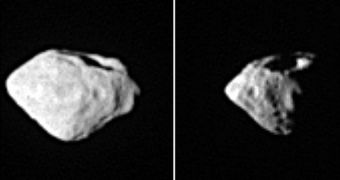As Rosetta, the ESA (European Space Agency) space probe launched in 2004, marched on towards its destination, the 67P/Churyumov-Gerasimenko comet, it sent its first images back to Earth.
As it turns out, the images are of the Type E asteroid known as Steins, a 5 km-wide rock in the shape of a diamond, brighter than most others, as it reflects 35% of the sunlight it receives. This rare kind of cosmic body resides in the main asteroid belt located between Mars and Jupiter, a type of debris left from the formation of the solar system. "Steins looks like a diamond in the sky," says Uwe Keller of the Max Plank Institute for Solar System Research in Lindau, Germany, who is in charge of the probe's main cameras. "We observed a new jewel in the solar system," he added.
On Friday, at 18:58 GMT, the small unmanned probe took the photos with an OSIRIS wide-angle camera, from a safe distance of 800 km (500 miles). Fifteen instruments were turned on for this event while the craft flipped 180 degrees in order to get a better shot as it raced past the asteroid with a relative speed of 30.720 km/h (19.200 mph). According to Andrea Accomazzo, the person in charge of spacecraft operations, "It was a race against time. The last command (to Rosetta) was three hours before the close encounter." The whole operation took place 360 million km away from Earth.
The pictures show Steins as a rock mass on which 4 sharp points and 9 craters can be easily spotted. Two of the craters are bigger in size, the largest of which measures about 2 km across and is situated on top of the "diamond." The rest of 7 form an intriguing line, probably as a result of repeated collisions with smaller similar objects. There is also a group of 15 smaller holes present on the surface, a rare feature for an asteroid so small, which indicates that Steins is very old.
Type E asteroids are mostly formed of basalts and silicates. Studying them may provide data on the physical composition of planets and on the events that take place in the near space as well as help protect Earth from collisions with such celestial wanderers. As project scientist Rita Schulz states, "If we want to know how our Solar System formed and evolved subsequently... then we have to look into other Solar System bodies."
The 1 billion Euro ($1.45 billion) probe is the first European spacecraft, and the 8th in the world (alongside 6 belonging to the US and one to Japan), to ever pass by an asteroid. In 2010, Rosetta will register its second encounter of this kind while meeting 21 Lutetia, a 100 km asteroid. Finally, it will reach its rendezvous point with the 67P/Churyumov-Gerasimenko comet in 2014. Once its trek is completed, it will send a miniature lab to the surface of the comet in order to perform a series of tests and experiments.

 14 DAY TRIAL //
14 DAY TRIAL //